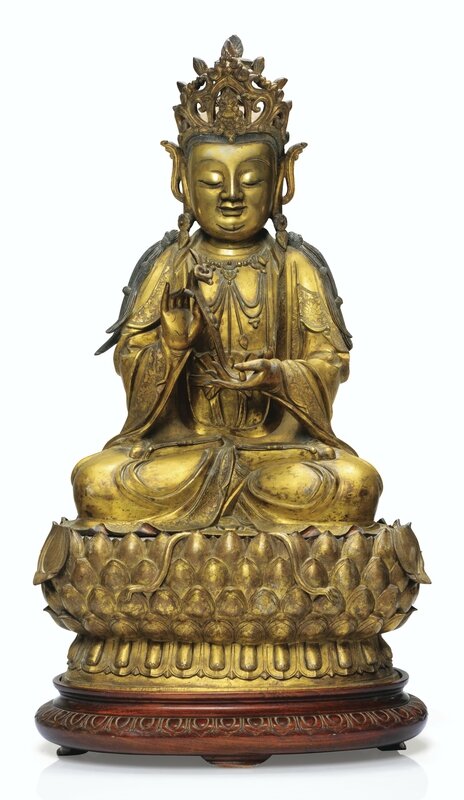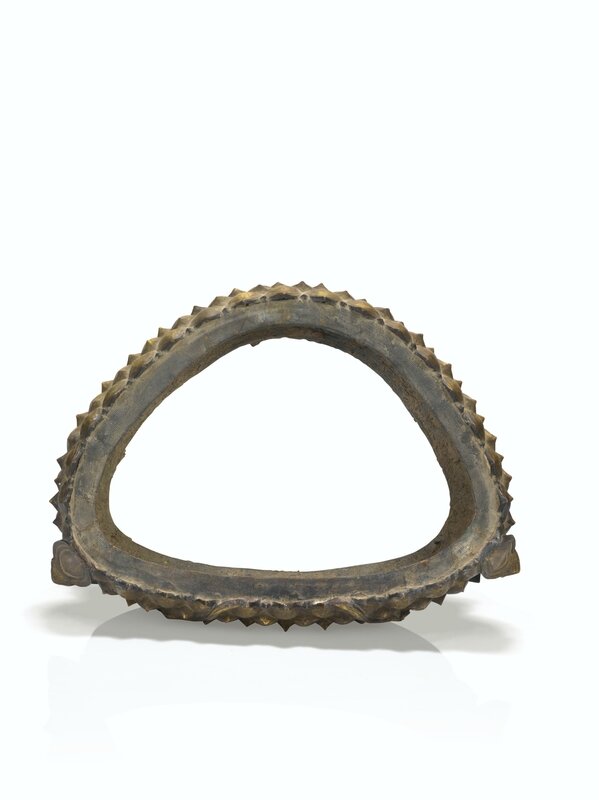Importante statuette de Samantabhadra en bronze doré, Dynastie Ming, XVIe-XVIIe siècle
Lot 43. Importante statuette de Samantabhadra en bronze doré, Dynastie Ming, XVIe-XVIIe siècle. Estimate 100,000 — 150,000 €. Lot sold 447,000 €. Photo: Sotheby's.
assis en dhyanasana sur une base lotiforme, tenant un sceptre ruyi dans les mains, vêtu d'une fine robe aux bords délicatement ciselés de rinceaux floraux, retombant en large plis sur ses jambes, la poitrine découverte révélant une parure élaborée, le visage avec une expression sereine, couronné d'une haute coiffe ajourée, la chevelure coiffée en chignon avec quelques mèches retombant sur les épaules, reposant sur une base lotiforme séparée, socle en bois postérieur (3) - 66,2 cm; 26 1/8 in.; avec le socle 76 cm; with wood stand 30 in.
A rare large gilt-bronze figure of the bodhisattva Samantabhadra, Ming dynasty, 16th-17th century
Note: Samantabhadra, the bodhisattva of compassion, is considered the manifestation of dharmakaya, the source of all things and the essence to which all things return. He is the first of the Five Dhyani Bodhisattvas and is commonly portrayed together with his companion the Bodhisattva Manjusri to the right of the Shakyamuni Buddha. He is more commonly depicted riding on an elephant. The present figure is rare as the bodhisattva is depicted dressed in princely robes and wearing a bejewelled crown, and holding a ruyi-sceptre, an attribute more commonly assoicated with Daoism. Compare a bronze figure of Samantabhadra sold at Sotheby's London, 11th June 1996, lot 141, and a parcel-gilt bronze figure of slightly larger size, sold Sotheby's London, 11th May 2016, lot 71.
Sotheby's. Arts d'Asie, Paris, 23 Jun 2016

/https%3A%2F%2Fprofilepics.canalblog.com%2Fprofilepics%2F1%2F0%2F100183.jpg)
/https%3A%2F%2Fstorage.canalblog.com%2F03%2F02%2F119589%2F96711876_o.jpg)
/https%3A%2F%2Fstorage.canalblog.com%2F11%2F31%2F119589%2F94773502_o.jpg)
/https%3A%2F%2Fstorage.canalblog.com%2F20%2F83%2F119589%2F94772815_o.jpg)
/https%3A%2F%2Fstorage.canalblog.com%2F26%2F72%2F119589%2F75604929_o.jpg)
/https%3A%2F%2Fstorage.canalblog.com%2F59%2F60%2F119589%2F26458628_o.jpg)








/image%2F1371349%2F20240416%2Fob_3f6edc_438868891-1652442212192458-70192626099.jpg)
/image%2F1371349%2F20240416%2Fob_d2d582_438782719-1652440978859248-57071696236.jpg)
/image%2F1371349%2F20240416%2Fob_1d7e26_438687024-1652598068843539-15987531326.jpg)
/image%2F1371349%2F20240415%2Fob_308536_436292768-1650079115762101-83406494688.jpg)